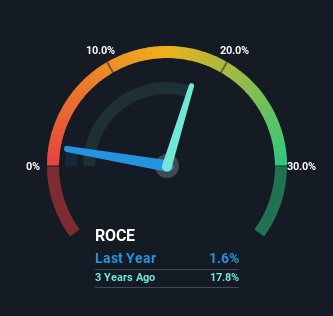- Italy
- /
- Semiconductors
- /
- BIT:OSA
Some Investors May Be Worried About OSAI Automation System's (BIT:OSA) Returns On Capital
There are a few key trends to look for if we want to identify the next multi-bagger. Amongst other things, we'll want to see two things; firstly, a growing return on capital employed (ROCE) and secondly, an expansion in the company's amount of capital employed. This shows us that it's a compounding machine, able to continually reinvest its earnings back into the business and generate higher returns. However, after briefly looking over the numbers, we don't think OSAI Automation System (BIT:OSA) has the makings of a multi-bagger going forward, but let's have a look at why that may be.
Return On Capital Employed (ROCE): What Is It?
Just to clarify if you're unsure, ROCE is a metric for evaluating how much pre-tax income (in percentage terms) a company earns on the capital invested in its business. The formula for this calculation on OSAI Automation System is:
Return on Capital Employed = Earnings Before Interest and Tax (EBIT) ÷ (Total Assets - Current Liabilities)
0.016 = €629k ÷ (€77m - €38m) (Based on the trailing twelve months to June 2023).
So, OSAI Automation System has an ROCE of 1.6%. In absolute terms, that's a low return and it also under-performs the Semiconductor industry average of 18%.
Check out our latest analysis for OSAI Automation System

In the above chart we have measured OSAI Automation System's prior ROCE against its prior performance, but the future is arguably more important. If you'd like, you can check out the forecasts from the analysts covering OSAI Automation System here for free.
So How Is OSAI Automation System's ROCE Trending?
When we looked at the ROCE trend at OSAI Automation System, we didn't gain much confidence. Over the last five years, returns on capital have decreased to 1.6% from 20% five years ago. Meanwhile, the business is utilizing more capital but this hasn't moved the needle much in terms of sales in the past 12 months, so this could reflect longer term investments. It's worth keeping an eye on the company's earnings from here on to see if these investments do end up contributing to the bottom line.
On a side note, OSAI Automation System has done well to pay down its current liabilities to 49% of total assets. That could partly explain why the ROCE has dropped. What's more, this can reduce some aspects of risk to the business because now the company's suppliers or short-term creditors are funding less of its operations. Some would claim this reduces the business' efficiency at generating ROCE since it is now funding more of the operations with its own money. Either way, they're still at a pretty high level, so we'd like to see them fall further if possible.
The Bottom Line On OSAI Automation System's ROCE
Bringing it all together, while we're somewhat encouraged by OSAI Automation System's reinvestment in its own business, we're aware that returns are shrinking. And in the last three years, the stock has given away 37% so the market doesn't look too hopeful on these trends strengthening any time soon. Therefore based on the analysis done in this article, we don't think OSAI Automation System has the makings of a multi-bagger.
On a final note, we found 3 warning signs for OSAI Automation System (2 don't sit too well with us) you should be aware of.
If you want to search for solid companies with great earnings, check out this free list of companies with good balance sheets and impressive returns on equity.
New: AI Stock Screener & Alerts
Our new AI Stock Screener scans the market every day to uncover opportunities.
• Dividend Powerhouses (3%+ Yield)
• Undervalued Small Caps with Insider Buying
• High growth Tech and AI Companies
Or build your own from over 50 metrics.
Have feedback on this article? Concerned about the content? Get in touch with us directly. Alternatively, email editorial-team (at) simplywallst.com.
This article by Simply Wall St is general in nature. We provide commentary based on historical data and analyst forecasts only using an unbiased methodology and our articles are not intended to be financial advice. It does not constitute a recommendation to buy or sell any stock, and does not take account of your objectives, or your financial situation. We aim to bring you long-term focused analysis driven by fundamental data. Note that our analysis may not factor in the latest price-sensitive company announcements or qualitative material. Simply Wall St has no position in any stocks mentioned.
About BIT:OSA
OSAI Automation System
Engages in the automation, electronics and applied laser, semiconductor, and service businesses in Italy, Asia, Africa, the Americas, and rest of Europe.
Slightly overvalued with very low risk.
Market Insights
Community Narratives



